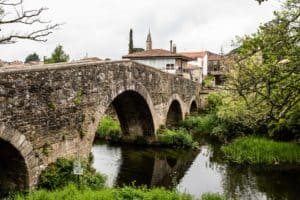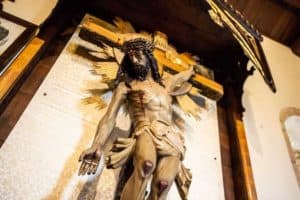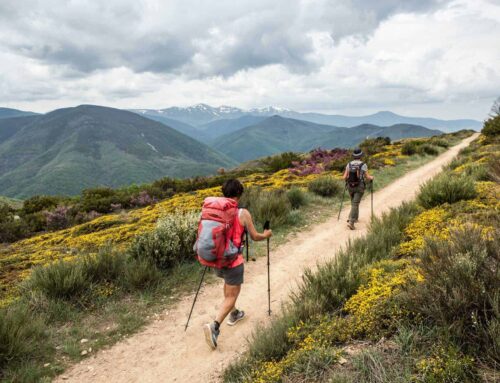Pulpo a Feira
Camino town of Melide
Melide, the town made famous by pulpo, is a very popular town along the Camino de Santiago. The Camino Frances and the Camino Primitivo join up at this stage. You pass through Melide three days before you walk into Santiago de Compostela on all of our fully supported Camino Frances Walking Tours. You will definitely not miss it as you will find all the restaurants filled with local people eating their favourite Galician dish, pulpo.
Melide is one of the oldest towns along the Camino de Santiago. It dates to the Neolithic Period, which is the historical period when people swapped to a farming lifestyle from their hunting and gathering past. Melide began to prosper and really establish itself around the 10th Century. This was because of the discovery of the remains of St. James and the start of the Camino de Santiago pilgrimage.
Furelos

Medieval Bridge of Furelos
One kilometer before the town of Melide you have the medieval town of Furelos. You enter Furelos on a bridge, that dates to the 12th century, and quickly find yourself on cobbled streets.

Church of San Juan
The church of San Juan, a very small chapel sitting right when you come into town, is worth a visit because of its unusual crucifix.

Church of San Juan
It does not depict Jesus with this hands outstretched to both sides. He has one hand reaching up to Heaven; and one hand reaching down to pull you up into him. You can also find a replica stamp of this crucifix for your pilgrim’s passport.
Melide, not a sea side town
Pulpo, or octopus, has become one of the signature foods of the people of Melide. This is quite unusual as Melide is not close to the sea. The town is about 100kms from the nearest sea side town in Galicia. The fable goes that because of the popularity of the town of Melide, due to the hustle and bustle of the Camino de Santiago, sellers would drive their pulpo in to the Market every week to sell their delights from the sea.
You must be wondering how tons of octopus made it to the market to sell without spoiling? Well, pulpo, prepared in the traditional Galician style or Pulpo a Feira, is always frozen before being cooked in pots of salty water.
If you were to find yourself amongst the stalls of this historic market, you would eat pulpo topped with rich olive oil and your choice of sweet, smoked or spicy paprika (of course with a chunk of Galicia bread as your plate). You would drink the local white wine out of small bowls rather than typical stemmed wine glasses. To top it off, you would then fulfil your sweet tooth with sweet and crispy churros.
A Garnacha, Pulperia

A Garnacha
We make sure we keep this tradition alive every time we pass through the town of Melide on our walk to Santiago de Compostela. Our favourite restaurant in Melide to eat pulpo is Pulperia A Garnacha, which the owner is a third generation pulpeiro. You can often find him in the front window preparing the pulpo for passing pilgrims. You will normally find us eating the pulpo at one of his tables!
Galician Traditional Pulpo Recipe
Ingredients:
- 1 previously frozen but thawed octopus
- 3 medium potatoes
- Salt
- Paprika
- olive oil
Method:
Clean the octopus very well. Do remove all of the viscera. Bring a large pot of water to boil on high heat.
When the water is boiling, hold the octopus by the head and dunk it into the boiling water. Each time, count to 3 and then take it out. Repeat this for a total of 3 times. This method ensures the skin of the octopus will remain attached.
After dunking the octopus 3 times, submerge the octopus into the pot (totally covered with the water). Cook for about 25 minutes for each 1 kg of octopus.
Once the time has elapsed for the size of your octopus, turn off the burner and leave it siting for a further 20 minutes in the same water.
After 10 minutes, take the octopus out of the water and let it cool down.
Cook the potatoes with the skin in the same pot of cooking water as the octopus. Boil the potatoes until they are well cooked. Remove them and let them cool a little. Once you are able to, peel all of the potatoes.
Cut the potatoes into thick slices and arrange them on the base of a plate. Typically this would be a wooden plate. (You can find these plates to purchase in many shops in Santiago de Compostela at the end of your walk!)
Cut the octopus, about half a finger thick, and place on the potatoes.
Add salt, sprinkle with paprika (sweet or spicy) and top generously with a good quality olive oil.







Leave A Comment